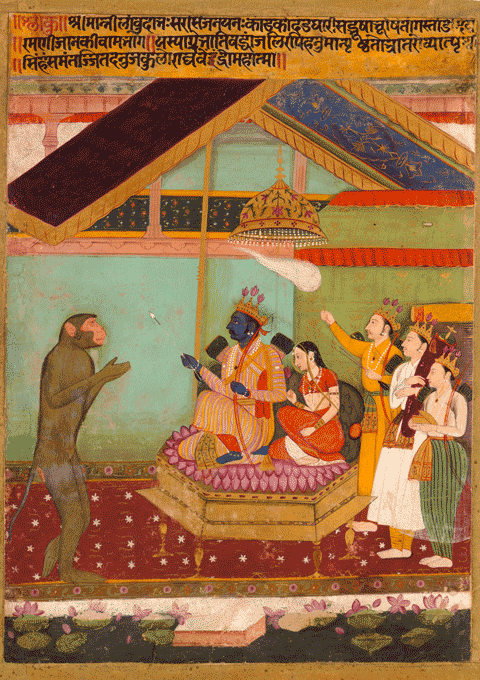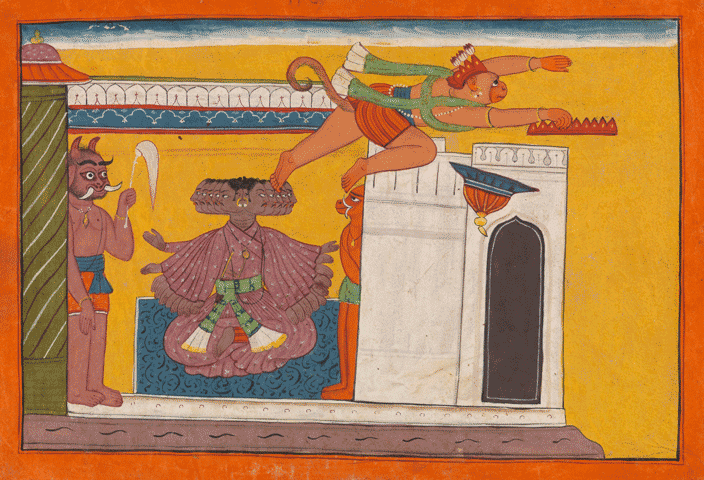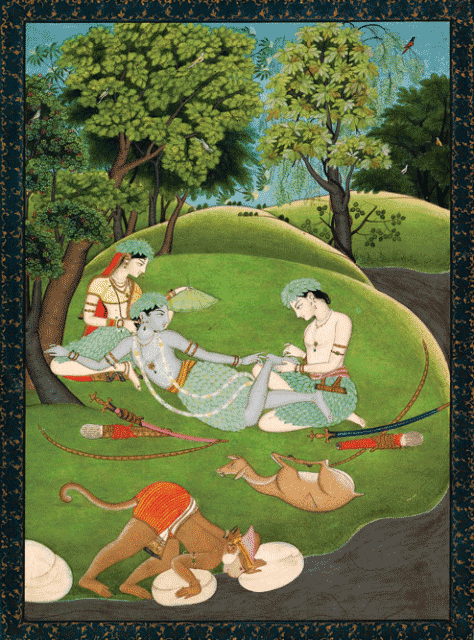In August 2019, the Metropolitan Museum of Art launched its latest exhibition on Sita and Rama: The Ramayana in Indian Painting. The paintings in the exhibition illustrate the collective creativity of the Ramayana, an epic narrative written by the Sanskrit poet Valmiki around the fifth century B.C. Created during the seventeenth and nineteenth centuries by the Rajput and Pahari courts of northern India, these magnificent paintings are still on show today. The exhibition also includes a variety of textiles from all over South Asia, artworks depicting the hero Rama’s rescue of his beloved wife, Sita, from the capture of Ravana, a wicked demon with ten heads. The images hold intense themes of morality, kinship and Rama’s status as the divine embodiment of Vishnu.
The highlight of the exhibition are three incredible works of art shown in rotations. It includes a 19th century painting titled Tantric Form of Monkey God Hanuman, a 19th century masterpiece entitled Rama, Sita, Laxamana Begin Their Life in the Forest which embodies a Pahari tradition of painting, and a rare 18th century textile piece titled The Combat of Rama and Ravana. These three paintings demonstrate the sacred position of the Ramayana in Hindu tradition and practice today.
The 2,500 year old text recounts the life of King Rama, the abduction of his wife Sita by the evil King of Lanka, Ravana, his confrontation with Ravana and the subsequent rescue of Sita. The chosen artworks provide clear visual illustrations of this Sanskrit narrative and effectively cover its multiple dimensions across two mediums. The paintings represent a single event and are closely related to the text of the Ramayana, while the textiles present main characters and climatic events such as the final battle between Rama and Ravana. Together, these two mediums effectively accompany one another to convey the narrative and emphasize the richness of Indian art and textile practices.

The Pahari and Rajput traditions of art are intricately associated with Mughal art. In the 17th century, these regional art styles flourished enormously in the midst of a crisis. In 1658, after Aurangzeb had risen to the throne of the Mughal Emperor, there was a decline in Mughal painting workshops, as Aurangzeb was more interested in architecture than visual art. During this period, artists trained in the Mughal painting workshops began to journey through Rajasthan in search of new ways to develop their art. These artists contributed to a number of innovative new ways in which religious and secular art manifested during this time period. In the series of 30 artworks depicting the Ramayana at the MET, each one stands out for the distinctive theme, format, and creativity of the regional artists.

The 19th century piece titled Rama, Sita, Laxamana Begin Their Life in the Forest belongs to the Kangra region. It illustrates Ram resting his head in his wife’s lap, while his brother tries to remove a thorn from his foot. The presented scene is profoundly personal, transforming the unassuming spectator into a voyeur. The gods’ leaf-trimmed garments and head-dresses represent their lives as forest dwellers. In the front, Hanuman is presented with his arched back and saffron loincloth, drinking the river water. The characters in this art are truer to the human form, their characteristics are refined and gentle, reflecting the intimate bond between each individual. There is a great emphasis placed on sentiment and on how nature represents the emotional condition of these characters.

The late 19th century piece from Rajasthan titled Tantric Form of Monkey God Hanuman portrays Hanuman, a mighty monkey warrior and an ally of Rama in a tantric five-headed pancha mukha form. This piece depicts Hanuman marching boldly as he tramples on demons and releases an arsenal of weapons towards his opponent. Above his crown are five animal heads synonymous with heroic and aggressive acts of Lord Visnu. As a child, Hanuman mistook the sun for a ripe fruit and tried to eat it. After the gods intervened, he was granted immortality, protection from fire and water, and the power to move faster than the winds. He was given a weapon, the gada, which he carries in his raised hand. This image was created for use in tantric ceremonies, making it a rare and unique addition to the exhibition.

The 18th century textile piece, The Combat of Rama and Ravana illustrates the ultimate battle in the Ramayana, when Rama, Hanuman and their armies battle against Ravana and his army of demons. In the painting, Rama and Ravana are preparing to fire magical arrows at each other. Laxmana, Rama’s brother, stands behind him stringing his bow while Hanuman prays to his Lord. Hanuman’s army carries rocks to build the land bridge to Lanka (Sri Lanka) to rescue Rama’s wife, Sita. The frontline is packed with warriors and dismembered bodies. This vibrant and captivating piece of South Indian textile painting reveals the desire to capture the energy and chaos of the epic battle.

Today, these paintings remain captivating and symbolic, providing a glimpse of how contemporary audiences interpreted this extraordinary story. The vivid colours reflected in the paintings capture the attention of the viewer and make them feel as though they were part of the heroic epic. Each of these artworks provides not only an imaginative visual form to the story, but also represents the intricate craftsmanship and colour palette of the artists. These narratives of folklore and kinship will continue to resonate with individuals for generations to come.
For more information on the MET Exhibition or to visit the Exhibition itself, visit https://www.metmuseum.org/exhibitions/listings/2019/sita-and-rama-ramayana-indian-painting
